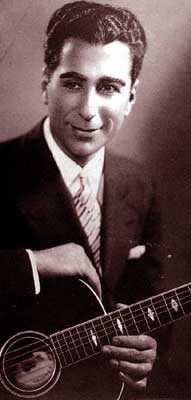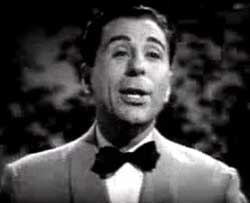 Nick Lucas sings Tip Toe Thru the Tulips (1944) as though it weren't a campy song, & it's rather a sweet piece sung seriously by a very old-fashioned singer.
Nick Lucas sings Tip Toe Thru the Tulips (1944) as though it weren't a campy song, & it's rather a sweet piece sung seriously by a very old-fashioned singer.
The wee film gives a set-up with Nick in a garden serenading with only guitar accompaniment, to a gal up on a balcony. Halfway through, she comes down in the garden & dances for him, an almost serious modern-jazz dance with art deco poses.
Nick looks younger than his actual age here. He had risen to national prominance singing the same song in his prime in Gold Diggers of Broadway (1929), the song having been at that time written especiall for him by Al Dubin & Joe Burke. It remained forever his signature song.
Nick had been performing since the 'teens & was briefly a big star from the mid-20s to early-30s, with an enormous following in Europe too, setting attendance records at the London Palladium & the Kit Kat Klub.
But feeling like a bigshot, he made a bonehead mistake in passing up a seven-year contract with Warner Brothers who would've made him both a film & recording star. Passing on that opportunity, he bounced around a bit & tried to make a go of it without big-company support, & ended up with no recording contracts at all. And Dick Powell got all the roles Warner would've gone to Nick!
Yet he would make periodic if always tepid comebacks in each decade to follow, beginning with this & three other soundie performances all in 1944. In 1951 he made seven Snader telescriptions. And though not otherwise much visible, he was in fact always performing live somewhere or another.
After Tiny Tim turned Nick's most famous song into a ultra-kitschy novelty hit, Nick got a new boost of interest & made several television guest appearances, invariably singing only the Tulips song, which is the only pathetic thing about the lingering interest in him, since he did sing much else once upon a time, & over his lifetime had sold 84 million records. But toward the end he was just riding Tiny Tim's coattails, which is truly hitching your wagon to a hamster.
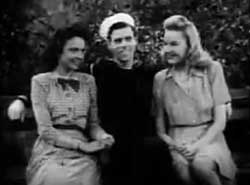 Contrary to the impression one got if they were around back in the '60s or early '70s when Nick was singing "Tip Toe" on Ed Sullivan, Lawrence Welk, or Johnny Carson & such shows, he really was doing other material. The soundies having first gotten "Tip Toe" out of the way went on to let him do a couple others.
Contrary to the impression one got if they were around back in the '60s or early '70s when Nick was singing "Tip Toe" on Ed Sullivan, Lawrence Welk, or Johnny Carson & such shows, he really was doing other material. The soundies having first gotten "Tip Toe" out of the way went on to let him do a couple others.
Side By Side (1944) is again set in the garden, but benches have been brought onto the set & it's been made to look like a public park, & Nick a strolling minstrel wandering amidst lovers, having always liked to bill himself as "America's troubadore." The song, written by Harry Woods, had been a hit record for Nick in 1927.
A soldier home on leave sits with his girlfriends, & a lascivious policeman is leaning over a girl in the park by herself, plus other couples are in the park.
This scarcely sets the mood for when Nick walks in & sings as nicely as anyone's talented grampa "Oh we ain't got a barrel of money/ Maybe we're ragged & funny/ But we'll travel along, singing a song, side by side."
He strums up considerable charm if you're not expecting a great talent. But I'd been listening to Billie Holiday earlier today, & Noble Sissle last night, so a fardling nostalgia act like Nick's seems so trivial alongside immortals.
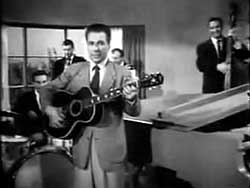 Looking at the World Through Rose Colored Glasses (1951), a tune by Tommie Mallie & Jimmy Steiger that Nick first recorded in 1926, became one of seven Snader telescriptions Nick Lucas made in 1951.
Looking at the World Through Rose Colored Glasses (1951), a tune by Tommie Mallie & Jimmy Steiger that Nick first recorded in 1926, became one of seven Snader telescriptions Nick Lucas made in 1951.
It's a jaunty almost childlike song: "I said goodbye to Mr. Sorrow/ How do you do Mr. Joy/ No need to worry 'bout tomorrow/ Look at me/ And you'll see."
The tune is very simple as Nick only wrote simple songs, & his sheet music was thus popular among amateur guitarists.
Not a good song, it isn't helped by back-up from a mediocre quintet, which appears to include Lawrence Welk's accordionist Myron Floren together with double base, piano, & drum.
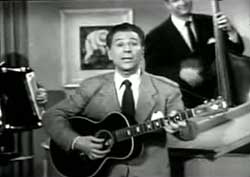 In the same room where he filmed Look at the World Through Rose Colored Glasses a second telescription was made, this time with Nick singing in Neopolitan Marie, Ah Marie (1951). In the same room where he filmed Look at the World Through Rose Colored Glasses a second telescription was made, this time with Nick singing in Neopolitan Marie, Ah Marie (1951).
Myron behind him on accordion gets a solo, as does the pianist. Nick's additionally accompanied by a double base player & a drummer. I can imagine this number being great sung by Louis Prima but it's only passable from Nick.
By now one might reasonably asked "How did this guy ever have even a moderate singing career? Let alone a moment of greater success in the late 1920s. Was he formerly a lot better than this? Well, no, these soundies & telescriptions capture him pretty much as he always was.
He come to be categorized as a "corn" singer, which most often meant hillbilly joke songs by the likes of the Korn Kobblers or Homer & Jethro, & swing wackies like Spike Jones. By the time Nick was making soundies & telescriptions, there was no room for upper register tenors of a "serious" pop style unless they'd hooked their wagon to a bigger star, as Dennis Day hooked his to Jack Benny.
But if there wasn't much room for a old-time tenor without the rest of the barbershop quartet, there was a lot of call for korn which proliferated in the soundies. So Nick slipped in under the wire.
He'd obviously rather be remembered as a crooning tenor, & when he hit it big in the 1920s in spite of such a small but charming talent, it was because stage producers & record companies were always on the look-out for another Rudy Vallee.
Producers with an eye for the buck & not the art could tell Rudy couldn't sing all that well, but he was a cash-generating river of popularity.
In imagining clones in guys like Nick, producers failed to fathom that Rudy had tremendous vigour & style & so extravagantly overcame the technical limitations of his voice that he was a great talent. Nick wasn't. But it was the right decade to be promoted as another of those "collegiate" style singers, whiter than white & often to be seen in a racoon coat & a rah-rah flag for their school's team.
It was not long before this style just wasn't the in thing. But lacking versatility, Nick could never grow or change. He could only continue to remind booking agents & venues that he sold two million copies of "Tip Toe Thru the Tulips" to their grandparents.
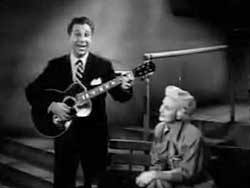 Not nearly as awful as Marie, Ah Marie or Rose Colored Glasses is his telescript for the Turk & Ahlert standard Walkin' My Baby Back Home (1951), which had been a hit for Nick in 1931. Not nearly as awful as Marie, Ah Marie or Rose Colored Glasses is his telescript for the Turk & Ahlert standard Walkin' My Baby Back Home (1951), which had been a hit for Nick in 1931.
He walks onto the set with a girl who is strumming the guitar he's holding, a crass commercial reminder that Nick made a good deal of his income selling songbooks with easy guitar lessons.
The gal then sits down, & Nick sings the song with the same stylization he would've been using in 1929.
It has a certain campy authenticity at least, & he does kind of remind one of the "youth singer" Dick Powell became in the movies after Nick turned down that contract.
And to think, this guy came that close to being the star Dick Powell became singing the tenor youth role on the top of the circling cake crooning to scores of Ziegfield Follies babes -- in the biggest musicals of the 1930s & '40s, but he thought he was bigger than that.
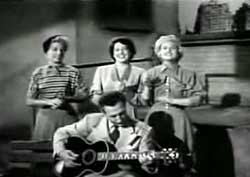 The notion that Nick might ever sing a sad song is like imagining My Pretty Pony being ridden into battle by Barbie's best friend Midge Hadley.
The notion that Nick might ever sing a sad song is like imagining My Pretty Pony being ridden into battle by Barbie's best friend Midge Hadley.
Did you even know Midge had a last name? So did Barbie -- her total name is Barbie Millicent Roberts, & her boyfriend was Ken Roberts, so must've been an incest couple. But hooboy do I digress.
In another three-minute telescription Nick sings I Love the Shinshine of Your Smile (1951). The setting appears to be a rooftop with the same cheap lead-pipe handrailed staircase that looked like a basement when used in Walking My Baby Back Home.
He walks down the steps to the gloomy part of the set to sing about the sunshine smile. As usual he comes off as a talented grampa at a family party who couldn't possibly be a professional entertainer. But sure, it's fun to hear grampa singing old tunes.
He actually does some minor guitar-picking on this one, just one or two strings it looks like, rather than his usual Guitar 101 strumming.
It's hard to believe he actually was a famous guitarist & one of his claims to historical significance is having cut Pathe Record's first guitar solo 78 in 1922, "Picking the Guitar" & "Teasing the Frets," & lent his name to a deep-bodied Gibson guitar which was in fact an excellent guitar.
It remains he was no Les Paul & it seems to me that his popularity as a guitarist was really in his ability to prove to anyone who wanted to play one that they could, & then deliver on that promise.
The three harmony biddies seen in other of his telescriptions come down the steps to join the song. They sing a verse in that generic girl-harmony manner. Then Nick finishes the song off somewhat like Jack finished off Elizabeth Stride.
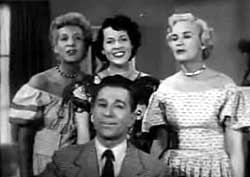 Since Nick was already a nostalgia act, Get Out Those Old Records (1951) was a natural piece for him, originally a Guy Lombardo number. In Nick's hands, it's more like "Get Out Those Crappy Old Records."
Since Nick was already a nostalgia act, Get Out Those Old Records (1951) was a natural piece for him, originally a Guy Lombardo number. In Nick's hands, it's more like "Get Out Those Crappy Old Records."
The three-minute film opens with three biddies in their living room looking through some 78 lacquer discs, when whadayaknow, Nick Lucas walks right into their house like the Man from Glad, with his guitar so they didn't need the records after all.
"Get out those old records/ Those old phonograph records/ The ones we used to play so long ago/ What if they sound scratchy/ The tunes really were catchy/ Especially those that said I love you so."
He then puts his guitar down though an invisible band keeps playing. He winds an old phonograph & puts a record on it. Then the biddies join in to sing the song in harmony while Nick actually makes an effort to do something interpretive with the number, & sounds like he'd been given lessons to Dennis Day.
It's kind of like someone took "Gimme That Old Time Religion" & accepted a bet with someone that he could rework the tune to be so bad it'd make a crackwhore sleepy.
Musically feeble, still, in the 1951 these telescriptiosn may well have helped popularize the guitar, at a time when young boys were still eager to learn to play the gawdawful accordion, which would change to guitar in the 1960s.
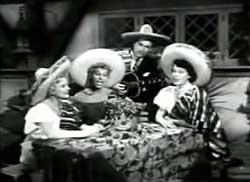 Struggling for mood, Nick tossed a Mexican blanket over his shoulder & donned an ill-fitting sombrero borrowed from a La Fiesta Restaurant. That got him all ready to sing Mexicali Rose (1951). Struggling for mood, Nick tossed a Mexican blanket over his shoulder & donned an ill-fitting sombrero borrowed from a La Fiesta Restaurant. That got him all ready to sing Mexicali Rose (1951).
Maybe I listened to too much of this guy & I'm going soft in the head, but I rather liked this little performance. It even suddenly seemed rather heroic of him to keep being an entertainer with only this much talent.
He smiles not too big & with real sincerity, like he really deep inside hopes he's pleasing an audience.
About halfway through Nick saunters over to a one of the tables at La Fiesta where three women are sitting with the other hats taken off the wall, & the exact same blanket (probably on sale that day at Woolworth's Five & Dime), folded in the exact manner & tossed over their shoulders. They do a verse as a harmony group & aren't awful if you're into stuff like the Lennon Sisters on Lawrence Welk.
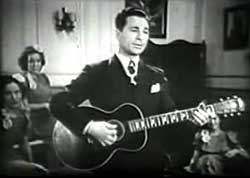 A one reel musical comedy Yankee Doodle Home (1939) stars Nick Lucas & Vince Barnett pretty much playing themselves.
A one reel musical comedy Yankee Doodle Home (1939) stars Nick Lucas & Vince Barnett pretty much playing themselves.
They are fired by the music publishing company because the songs they've been writing have bombed. They decide the best thing to do is scam the company & Vince in disguise pretends to be a producer who wants only songs by Lucas & Barnett, which gets them their old job back.
As a comedy the film's not much. As a crime film I guess we're just not supposed to notice that two talentless dweebs have committed fraud.
Two songs are more important to the film than the story, not that the songs are any good. "I'm a Very, Very Private Secretary" is sung by Jean Walters, a performer so little known she makes Nick Lucas look like Broadway's biggest headliner of all time.
Nick sings "Great American Home," a perfectly dreadful number performed as dreadfully as it merits. It begins: "There's a lot of loyal yankees in our neighborhood/ Every one is one hundred percent/ Right across the street from me/ Lives a jolly family/ Full of patriotic sentiment."
The song proceeds to describe a family nutters who've painted all the furniture & kitcheware in the house red white & blue, play Yankee Doodle Dandy all the live long day, & have an American flag fetish.
But then the surprise in the lyrics turns out to be that "Nobody speaks a word of English in that great American home." If it were written today the last verse would be about deporting them back to Mexico.
So like all Nick's music, it's goodhearted, suitable to a children's party in any right-wing household, or the sort of thing forced upon a helpless captive audience in an elder care facility.
About half of the song's length is given over to portraits of immigrant families which have become Americanized, casting off their cultural distinctions to blend into the melting pot.
The three harmonizing gals who join Nick for the climactic verses have gotten to be a bit on the hag side by the time they do the Snader telescriptions but are cute enough here. Not cute enough in Nick's estimation to ever give them a line of credit, however.
Some of the actors who played the immigrant residents of great American homes get a line or two within the song, then we see the American flag, the end, by gum, let's all join the army now.
These are of course late performances for a performer who was at his height in the 1920s, & I'll have to prepare a second page on Nick Lucas for his few early musical appearances. But I can tell right you, he wasn't a lot better in his prime.
If you listen to the 1920s songs of, say, Ukulele Ike, you'll find out how full of charm music from this era can be with just one guy singing alone with ukelele or guitar, & Nick just isn't in the immortals' lane.
copyright © by Paghat the Ratgirl
|
